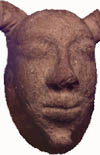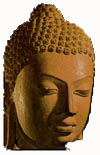| Sculptures |
The first sculptures in India date back to the Indus Valley civilization, where stone and bronze carvings have been discovered. This is one of the earliest instances of sculpture in the world. Later, as Hinduism, Buddhism and Jainism developed further, India produced some of the most intricate bronzes in the world, as well as unrivaled temple carvings. Some huge shrines, such as the one at Ellora were not actually constructed using blocks, but instead carved out of rock, making them perhaps the largest and most intricate sculptures in the world.
During the 2nd to 1st century BC in far northern India, in what is now southern Afghanistan and northern Pakistan, sculptures became more explicit, representing episodes of the Buddha’s life and teachings. Although India had a long sculptural tradition and a mastery of rich iconography, the Buddha was never represented in human form before this time, but only through some of his symbols.
The pink sandstone sculptures of Mathura evolved during the Gupta period (4th to 6th century) to reach a very high fineness of execution and delicacy in the modeling. Newer sculptures in Afghanistan, in stucco, schist or clay, display very strong blending of Indian post-Gupta mannerism and Classical influence, Hellenistic or possibly even Greco-Roman. Meanwhile, elsewhere in India, less anatomically accurate styles of human representation evolved, leading to the classical art that the world is now familiar with, and contributing to Buddhist and Hindu sculpture throughout Asia.
|
| Hindu Art |
 |
| The 4th, 5th and 6th centuries AD witnessed a tremendous resurgence of Hinduism when it became the official religion of the Gupta Empire. Consequently, this era was also marked by the emergence of innumerable images of popular Hindu Gods and Goddesses. Images of Vishnu, Shiva, Krishna, the Sun-God and goddess Durga evolved in this period. The Udaigiri caves in Madhya Pradesh house a colossal image of Vishnu. Here he is ...[read more]
|
| Sculptures of the Indus Valley |
 |
The story of Indian art and sculpture dates back to the Indus valley civilization of the 2nd and 3rd millennium BC. Tiny terra-cotta seals discovered from the valley reveal carvings of peepal leaves, deities and animals. These elemental shapes of stones or seals were enshrined and worshipped by the people of the civilisation.[read more] |
|
| Buddhist Sculptures |
 |
The next golden chapter of Indian sculpture opens in the 3rd century BC, when the Mauryan Emperor Ashoka adopted Buddhism and set out on a mission to spread the teachings of the faith as far and wide as possible. He had 85,000 stupas or dome-shaped monuments constructed with the teachings of Buddhism engraved on rocks and...[read more] |
|
|
| Featured Paintings Gallery - Orissa Tribal |
|
|
|
